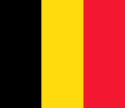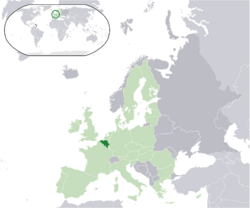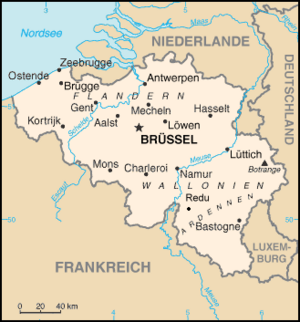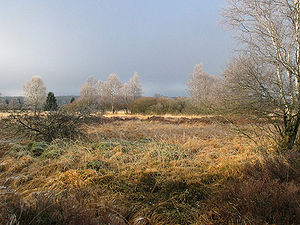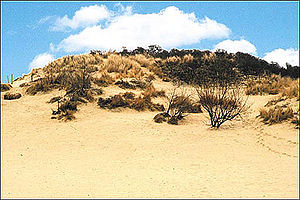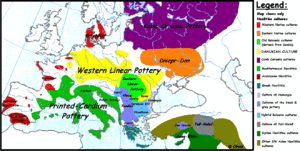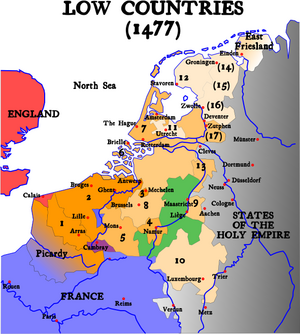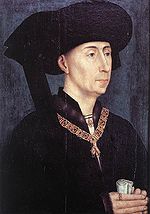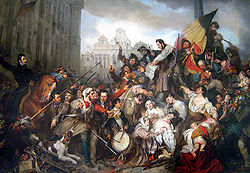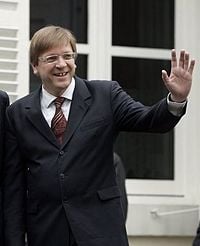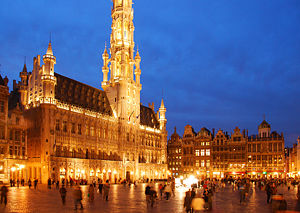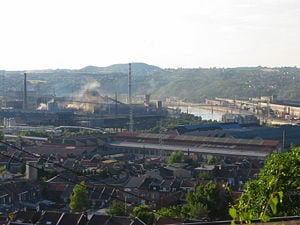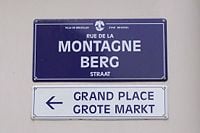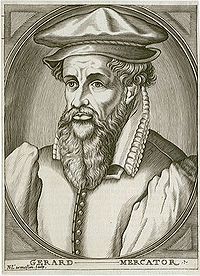Belgium
| (Dutch) Koninkrijk België (French) Royaume de Belgique (German) Königreich Belgien Kingdom of Belgium | |||||
| |||||
| Motto: Eendracht maakt macht (Dutch) L'union fait la force" (French) Einigkeit macht stark (German) "Strength through Unity" | |||||
| Anthem: The "Brabançonne" | |||||
|
Location of Belgium (dark green)
– on the European continent (light green dark grey) – in the European Union (light green) | |||||
| Capital | Brussels 50°54′N 4°32′E | ||||
|---|---|---|---|---|---|
| Official languages | Dutch, French, German | ||||
| Government | Federal constitutional monarchy and bicameral parliamentary democracy | ||||
| - King | Albert II | ||||
| - Prime Minister | Guy Verhofstadt | ||||
| Independence | |||||
| - Declared | 4 October 1830 | ||||
| - Recognized | 19 April 1839 | ||||
| Accession to EU | 25 March 1957 | ||||
| Area | |||||
| - Total | 30,528 km² (139th) 11,787 sq mi | ||||
| - Water (%) | 6.4 | ||||
| Population | |||||
| - 2007 estimate | 10,584,534[1] | ||||
| - 2001 census | 10,296,350 | ||||
| - Density | 344.32/km² 892/sq mi | ||||
| GDP (PPP) | 2006 estimate | ||||
| - Total | $342.5-billion | ||||
| - Per capita | $33,000 | ||||
| HDI (2004) | |||||
| Currency | Euro (€)1 (EUR)
| ||||
| Time zone | CET (UTC+1) | ||||
| - Summer (DST) | CEST (UTC+2) | ||||
| Internet TLD | .be² | ||||
| Calling code | +32 | ||||
The Kingdom of Belgium is a country in northwest Europe bordered by the Netherlands, Germany, Luxembourg, and France, with a short coastline on the North Sea.
Straddling the cultural boundary between Germanic and Latin Europe, Belgium's two largest regions are Dutch-speaking Flanders in the north, with 58 percent of the population, and the French-speaking southern region of Wallonia, inhabited by 32 percent.
The Brussels-Capital Region is an officially bilingual enclave within the Flemish and near the Walloon Region, and has 10 percent of the population.
Historically, Belgium, the Netherlands and Luxembourg were known as the Low Countries, which used to cover a somewhat larger area than the current Benelux group of states. From the end of the Middle Ages until the seventeenth century, it was a prosperous centre of commerce and culture. From the sixteenth century until the Belgian revolution in 1830, many battles between European powers were fought in the area of Belgium, causing it to be dubbed "the battlefield of Europe" – a reputation strengthened by both World Wars. Upon its independence, Belgium eagerly participated in the Industrial Revolution, generating wealth and also a demand for raw materials; the latter was a factor during the era of its African colonies.
Geography
The name "Belgium" is derived from Gallia Belgica, a Roman province in the northernmost part of Gaul that was inhabited by the Belgae, a mix of Celtic and Germanic
Belgium shares borders with France, Germany, Luxembourg, and the Netherlands, and covers an area of 11,787 square miles (30,528 square kilometers), which is about the size of the state of Maryland in the United States.
Belgium is a low-lying country, with a broad coastal plain extending to the south-east from the North Sea and The Netherlands and rising gradually into the Ardennes hills and forests of the southeast, on which the Signal de Botrange forms the country's highest point at 2277 feet (694 meters).
Belgium has three main geographical regions: the coastal plain in the north-west, the central plateau, and the Ardennes uplands in the south-east. The coastal plain consists mainly of sand dunes and polders. Polders are areas of land, close to or below sea level that have been reclaimed from the sea, from which they are protected by dikes or, further inland, by fields that have been drained with canals. The second geographical region, the central plateau, lies further inland. This is a smooth, slowly rising area that has many fertile valleys and is irrigated by many waterways. Here one can also find rougher land, including caves and small gorges.
The climate is maritime temperate, with significant precipitation in all seasons. The average temperature is lowest in January (winter) at 37°F (3°C) and highest in July (summer) at 64°F (18°C) The average precipitation per month varies between 2.1 inches (54mm) in February or April, to 3.1 in (78mm) in July.
The low-lying plain of Flanders is drained by the Leie, Schelde, and Dender rivers flowing northeast to the Schelde estuary, plus several shipping canals. The Ardennes is a plateau cut into by the Meuse River and its tributaries.
Natural resources include construction materials, silica sand, and carbonates.
Belgium's flora includes digitalis, wild arum, hyacinth, strawberry, goldenrod, lily of the valley, and other plants common to temperate zones, while beech and oak are the predominant trees. Boar, fox, badger, squirrel, weasel, marten, and hedgehog are still found in Belgium. Aquatic life includes pike, carp, trout, eel, barbel, perch, smelt, chub, roach, bream, shad, sole, mussels, crayfish, and shrimp.
Flooding is a threat along rivers and in areas of reclaimed coastal land, protected from the sea by concrete dikes. The environment is under intense pressure from human activities, including urbanization, a dense transportation network, industry, extensive animal breeding, and crop cultivation. Air and water pollution have repercussions for neighboring countries. Uncertainties regarding federal and regional responsibilities have slowed progress in tackling environmental challenges.
Brussels is the capital of Belgium and it is the headquarters of most of the European Union's institutions. The metropolitan area had between 2.1 to 2.6 million people in 2006.
History
Prehistory
The oldest primitive flint tools found on the area of today's Belgium date to about 250,000 before present (BP). Evidence of Mousterian culture (c. 80,000–35,000 BP) has been found in the Ardennes caves in southern Belgium and in Belgian Limburg. A dugout pine canoe dating to 8500 BP, the oldest vessel known, was found at Pesse. Neolithic remains can be found today at Spiennes where there was a flint mine. Beaker culture, of the late Neolithic period (3300–2000 B.C.E.), left both megalithic and individual burial monuments and an array of collared flasks, buckets, bowls, battle-axes, and daggers. The first signs of Bronze age activity in Belgium date from around 1750 B.C.E., with evidence of farmhouses, and stables. Cattle were the main livestock. From 500 B.C.E., Celtic tribes settled in the region and traded with the Mediterranean world. Warrior chieftain graves at Hainaut, and Eigenbilzen were stocked with chariots and harnesses, and bronze weapons. From c. 150 B.C.E., the first coins came into use.
The earliest named inhabitants of Belgium were the Belgae (after whom modern Belgium is named). The population covered a significant area of Gaulish or Celtic Europe, living in northern Gaul at the time of the Roman occupation. The distinction between the Belgae to the North and the Gauls to the south of them is disputed, but it seems clear that the Gauls were the dominant group in the area until the Roman and Germanic influence came to dominate.
Roman rule
In 54 B.C.E., the Belgae were over-run by the armies of Julius Caesar, as described in his chronicle De Bello Gallico. In this same work Julius Caesar referred to the Belgae as "the bravest of all the Gauls" ("horum omnium fortissimi sunt belgae"). He cited the arrival of Germanic tribes from the north and east. What is now Belgium flourished as a province of Rome. This province was much larger than the modern Belgium and included five cities: Nemetacum (Arras), Divodurum (Metz), Bagacum (Bavay), Aduatuca (Tongeren), Durocorturum (Reims). At the northeast was the neighbouring province of Germania Inferior.
Romans abandoned forts in the area in the mid-third century, as a result of resurging Germanic tribes and encroachment of the sea. Julian, Caesar of Gaul, waged wars in the Low Countries between 355 and 360 and was able to strengthen the Rhine border. A great invasion by Germanic tribes in 406–407 ended Roman occupation. The Franks were given the task of defending the frontier.
Early Middle Ages
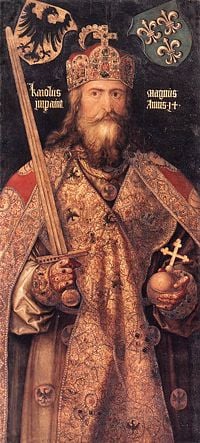
Childeric I (437-481) the first king of the Merovingian Franks, established his capital at Tournai, while his son Clovis I (466–511) extended the kingdom to include much of Gaul. He converted to Christianity. Christian scholars, mostly Irish monks, preached Christianity to the populace and started a wave of conversion (Saint Servatius, Saint Remacle, Saint Hadelin). The Merovingians were short-lived and were succeeded by the Carolingian Dynasty. After Charles Martel (686-741) countered the Moorish invasion from Spain (732 - Poitiers), the King Charlemagne (742/7-814) (born close to Liège) brought a huge part of Europe under his rule and was crowned the "Emperor of the Holy Roman Empire" by the Pope Leo III (800 in Aachen).
The Vikings were defeated in 891 by Arnulf of Carinthia near Leuven. The Frankish lands were divided and reunified several times under the Merovingian and Carolingian dynasties, but eventually were firmly divided into France and the Holy Roman Empire. The parts of the County of Flanders stretching out west of the river Scheldt (Escaut in French) became part of France during the Middle Ages, but the remainders of the County of Flanders and the Low Countries were part of the Holy Roman Empire.
As the Holy Roman Emperors lost effective control of their domains in the eleventh and twelfth centuries, the territory more or less corresponding to the present Belgium was divided into mostly independent feudal principalities: County of Flanders, Marquisate of Namur, Duchy of Brabant, County of Hainaut, Duchy of Limburg, Luxemburg, and the Bishopric of Liège. The rulers of these — both secular and spiritual — had a feudal relationship with the German king (the Holy Roman emperor). The count of Flanders held most of his land as the vassal of the French king, with the eastern part of his county being held in fealty to the German king.
In the thirteenth and fourteenth centuries, many cities gained their independence, there was huge trade within the Hanseatic League, huge gothic cathedrals and city halls were built.
During the eleventh and twelfth centuries, the Mosan art movement flourished in the region moving its centre from Cologne and Trier to Liège, Maastricht and Aachen. Some masterpieces of this Romanesque art are the shrine of the Three Kings at Cologne Cathedral, the baptistry of Renier de Huy in Liège, the shrine of Saint Remacle in Stavelot, the shrine of Saint Servatius in Maastricht or, Notger's gospel in Liège.
Part of Burgundy
By 1433, most of the Belgian and Luxembourgian territory along with much of the rest of the Low Countries became part of Burgundy under Philip the Good (1396-1467). When Mary of Burgundy, granddaughter of Philip the Good married Maximilian I (1459– 1519) , the Low Countries became Habsburg territory. Their son, Philip I of Castile (Philip the Handsome) was the father of the later Charles V (1500–1558). The Holy Roman Empire was unified with Spain under the Habsburg Dynasty after Charles V inherited several domains.
Especially during the Burgundy period (the fifteenth and sixteenth centuries), Ypres, Ghent, Bruges, Brussels, and Antwerp took turns at being major European centers for commerce, industry (especially textiles) and art. The Flemish Primitives were a group of painters active primarily in the Southern Netherlands in the fifteenth and early sixteenth centuries (for example, Van Eyck and van der Weyden). Flemish tapestries hung on the walls of castles throughout Europe.
xxxxx
During the Middle Ages small feudal states emerged, many of which rejoined as the Burgundian Netherlands in the fourteenth and fifteenth centuries. Emperor Charles V completed the union of the Seventeen Provinces in the 1540s, and unofficially also controlled the Prince-Bishopric of Liège.
The Eighty Years' War (1568–1648) divided the area into the northern United Provinces ('federate' Belgica Foederata in Latin) and the Southern Netherlands ('royal' Belgica Regia). The latter were ruled successively by the Spanish and the Austrian Habsburgs and comprised most of modern Belgium. Until independence the area was sought after by numerous French conquerors and was the theatre of most Franco-Spanish and Franco-Austrian wars during the seventeenth and eighteenth centuries.[2] Following the campaigns of 1794 in the French Revolutionary Wars, the Low Countries – including territories that were never nominally under Habsburg rule, such as the Prince-Bishopric of Liège – were annexed by the French First Republic, ending Spanish-Austrian rule in the region. The reunification of the Low Countries as the United Kingdom of the Netherlands occurred at the dissolution of the First French Empire in 1815.
The 1830 Belgian Revolution led to the establishment of an independent, Catholic, and neutral Belgium under a provisional government and a national congress. Since the installation of Leopold I as king in 1831, Belgium has been a constitutional monarchy and parliamentary democracy. Initially an oligarchy ruled mainly by the Catholic Party and the Liberals, the country had evolved towards universal suffrage by World War II with the rise of the Labour Party and trade unions playing a strong role. French, once the single official language and adopted by the nobility and the bourgeoisie, had by then lost its overall importance as Dutch had become recognized as well. However, it was not until 1967 that an official Dutch version of the Constitution was accepted.[3]
The Berlin Conference of 1885 gave the Congo Free State to King Leopold II as his private possession. In 1908, it was ceded to Belgium as a colony, henceforth called the Belgian Congo. Belgian control of the Congolese population, particularly under Leopold II, was savage, and the country was plundered of resources such as ivory and rubber.[4]
Germany invaded Belgium in 1914, as part of the Schlieffen Plan, and much of the Western Front fighting of World War I occurred in western parts of the country. Belgium took over the German colonies of Ruanda-Urundi (modern day Rwanda and Burundi) during the war, and they were mandated to Belgium in 1924 by the League of Nations, of which it was a founding member. The Treaty of Versailles had subjected several German border towns, most notably Eupen and Malmedy, to a plebiscite, which led to their annexation by Belgium in 1925, thereby causing the presence of a small German community. Belgium was again invaded by Germany in 1940 during the Blitzkrieg offensive, and occupied until its liberation by Allied troops in the winter of 1944–45. The Belgian Congo gained independence in 1960 during the Congo Crisis; Ruanda-Urundi followed two years later.
After World War II, Belgium joined NATO, headquartered at Brussels, and formed the Benelux group of nations with the Netherlands and Luxembourg. Belgium became one of the six founding members of the European Coal and Steel Community in 1951, and of the 1957 established European Atomic Energy Community and European Economic Community. The latter is now the European Union, for which Belgium hosts major administrations and institutions, including the European Commission, the Council of the European Union, and the extraordinary and committee sessions of the European Parliament.
Government and politics
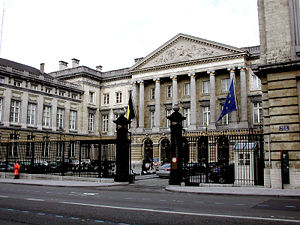
Constitutional structure
Belgium is a constitutional, popular monarchy and a parliamentary democracy.
The Constitution of Belgium was established in 1831, and revised in 1970 in response to conflict between the Dutch-speaking and French-speaking communities, to diffuse power to the communities and the regions. It was revised again in 1993, creating a federal state. The constitution is the primary source of law and the basis of the political system in Belgium.
The King of the Belgians is the constitutional head of the Belgian state and holds office for life. As head of state, the king plays a ceremonial and symbolic role. Following legislative elections, the leader of the majority party or the leader of the majority coalition is usually appointed prime minister by the monarch and then approved by parliament.
The bicameral Parliament consists of a Senate of 71 members, 40 of whom are directly elected by popular vote and 31 indirectly elected, to serve four-year terms, and a Chamber of Deputies of 150 members who are directly elected by popular vote on the basis of proportional representation to serve four-year terms. Suffrage is universal to those aged 18 years and over. Voting is compulsory so more than 90 percent of the population participates.
Belgium is a federation with a multi-party political system, with numerous parties have no chance of gaining power alone, and therefore must work with each other to form coalition governments. Almost all Belgian political parties are divided into linguistic groups, either Dutch-speaking parties, Francophone parties, or germanophone parties. The Flemish parties operate in Flanders and in the Brussels-Capital Region. The Francophone parties operate in Wallonia and in the Brussels-Capital Region. There are also parties operating in the comparatively small German-speaking community.
Political parties are thus organised along community lines, especially for the three main communities. There are no representative parties active in both communities. Even in Brussels, all parties presenting candidates are either Flemish parties, or French-speaking. As such, the internal organisation of the political parties reflects the fundamentally dual nature of Belgian society. There are no significant parties left who exist, or operate on a national, Belgian level.
From the creation of the Belgian state in 1830 and throughout most of the nineteenth century, two political parties dominated Belgian politics: the Catholic Party (Church-oriented and conservative) and the Liberal Party (anti-clerical and progressive). In the late nineteenth century the Labour Party arose to represent the emerging industrial working class.
Belgium is a highly unionised country, and organised labour is a powerful influence in politics. About 53 percent of all private sector and public service employees are labour union members. Not simply a "bread and butter" movement in the American sense, Belgian labour unions take positions on education, public finance, defence spending, environmental protection, women's rights, abortion, and other issues. They also provide a range of services, including the administration of unemployment benefits. Belgium's three principal trade union organizations are the Confederation of Christian Trade Unions (1,705,000 members), the General Federation of Belgian Labour (1,198,000 members) and the General Confederation of Liberal Trade Unions of Belgium which has 230,000 members.
The Court of Appeals is one level below the Court of Cassation, an institution based on the French Court of Cassation. The Court of Cassation is the most important court in Belgium. Judges are appointed for life by the Belgian monarch. The judicial system is based on civil law and originates from the Napoleonic code. It has a judicial review of legislative acts. It accepts compulsory ICJ jurisdiction, with reservations.
Political crisis
A string of Christian Democrat coalition governments from 1958 was broken in 1999 after the first dioxin crisis, a major food contamination scandal which led to the establishment of the Belgian Food Agency. The government led by Prime Minister Guy Verhofstadt from 1999 to 2007 achieved a balanced budget, some tax-reforms, a labour-market reform, scheduled nuclear phase-out, and instigated legislation allowing more stringent war crime and more lenient soft drug usage prosecution. Restrictions on withholding euthanasia were reduced and same-sex marriage legalized. The government promoted active diplomacy in Africa. Verhofstadt's coalition fared badly in the elections of 2007. Since then, as of November 2007, the country has been experiencing a long lasting political crisis. This crisis is such that many observers have speculated a possible partition of Belgium.
In its 2007 Worldwide Press Freedom Index, Reporters Without Borders ranked Belgium (along with Finland and Sweden) 5th out of 169 countries.
Political authority
The Federal State retains a considerable "common heritage". This includes justice, defense, federal police, social security, nuclear energy, monetary policy and public debt, and other aspects of public finances. State-owned companies include the Post Office and Belgian Railways. The Federal Government is responsible for the obligations of Belgium and its federalized institutions towards the European Union and NATO. It controls substantial parts of public health, home affairs and foreign affairs.
Communities exercise their authority only within linguistically determined geographical boundaries, originally oriented towards the individuals of a Community's language: culture (including audiovisual media), education, and the use of the relevant language. Extensions to personal matters less directly connected with language comprise health policy (curative and preventive medicine) and assistance to individuals (protection of youth, social welfare, aid to families, immigrant assistance services, etc.).
Regions have authority in fields that can be broadly associated with their territory. These include economy, employment, agriculture, water policy, housing, public works, energy, transport, the environment, town and country planning, nature conservation, credit, and foreign trade. They supervise the provinces, municipalities, and intercommunal utility companies.
In several fields, the different levels each have their own say on specifics. With education, for instance, the autonomy of the Communities neither includes decisions about the compulsory aspect nor allows for setting minimum requirements for awarding qualifications, which remain federal matters.[5] Each level of government can be involved in scientific research and international relations associated with its powers.
Military
The Belgian Armed Forces have about 41,000 active troops. They are organised into one unified structure which consists of four main components: The Army, the Air Force, the Navy, and the Medical Component.
Economy
Belgium operates a modern, private-enterprise economy has capitalized on its central geographic location, highly developed transport network, and diversified industrial and commercial base. It is one of the world's 10 largest trading nations. The economy is characterized by a highly productive work force, high GNP, and high exports per capita. The Belgian economy is heavily service-oriented and shows a dual nature: a dynamic Flemish economy, with Brussels as its main multilingual and multi-ethnic centre, and a Walloon economy that lags behind.
The people of Belgium enjoy a high standard of living. Belgium ranks ninth in the 2006 HDI, 24th on The Economist's 2005 world-wide quality-of-life index, and it has an average per capita income that has been estimated at $33,000 for the year 2006, 14th on the IMF list of 179 countries, and comparable to that of the United Kingdom, and Sweden.
Belgium was the first continental European country to undergo the Industrial Revolution, in the early 1800s. Liège and Charleroi rapidly developed mining and steelmaking, which flourished until the mid-20th century. However, by the 1840s the textile industry of Flanders was in severe crisis and the region experienced famine from 1846–50.
After World War II, Ghent and Antwerp experienced a rapid expansion of the chemical and petroleum industries. The 1973 and 1979 oil crises sent the economy into a recession; it was particularly prolonged in Wallonia, where the steel industry had become less competitive and experienced serious decline. In the 1980s and 90s, the economic centre of the country continued to shift northwards and is now concentrated in the populous Flemish Diamond area.
By the end of the 1980s, Belgian macroeconomic policies had resulted in a cumulative government debt of about 120 percent of GDP. As of 2006, the budget was balanced and public debt was equal to 90.30 percent of GDP. In 2005 and 2006, real GDP growth rates of 1.5 percent and 3.0 percent, respectively, were slightly above the average for the euro area. Unemployment rates of 8.4 percent in 2005 and 8.2 percent in 2006 were close to the area average.
One of the founding members of the European Union, Belgium strongly supports an open economy and the extension of the powers of EU institutions to integrate member economies. In 1999, Belgium adopted the euro, the single European currency, which fully replaced the Belgian franc in 2002. Since 1922, Belgium and Luxembourg have been a single trade market within a customs and currency union: the Belgium-Luxembourg Economic Union.
With few natural resources, Belgium must import substantial quantities of raw materials and export a large volume of manufactures, making its economy unusually dependent on the state of world markets. Exports totalled $283.8-billion in 2006. Export commodities included machinery and equipment, chemicals, diamonds, metals and metal products, and foodstuffs. Export partners included Germany 19.7 percent, France 16.9 percent, Netherlands 12 percent, UK 7.9 percent, and the US 6.2 percent, Italy 5.2 percent. Imports totalled $279.9-billion in 2006. Import commodities included machinery and equipment, chemicals, diamonds, pharmaceuticals, foodstuffs, transportation equipment, and oil products. Import partners included Netherlands 18.3 percent, Germany 17.3 percent, France 11.2 percent, UK 6.6 percent, Ireland 5.7 percent, and the US 5.4 percent.
Demographics
Population
Belgium's total population in 2007 was 10,296,350. Recent immigration has brought its population of foreign origin to 56 percent. The population density of Belgium is 886 per square mile (342 per square kilometre) – one of the highest in Europe, after that of the Netherlands and some microstates such as Monaco. The median age for the total population of 41.1 years in 2007. Almost all of the Belgian population is urban - 97 percent in 2004. Belgians had an average life expectancy at birth of 78.92 years (75.75 years for males and 82.24 years for females) in 2007.
Ethnicity
The country is ethnically split between its Fleming majority, 58 percent of the population, its Walloonian minority, 31 percent of the population, and about 73,000 Germans. The other 11 percent consists mostly of Europeans, Turks, Moroccans and Algerians.
The terms Fleming and Flemings denote respectively a person and people, and the Flemings or the Flemish or the Flemish people the population forming a community of more than six million people and the majority of all Belgians, of Flanders, the northern half of the country. The native Flemings descend from Germanic tribes, predominantly Franks, and mixed Celtic-Germanic "Gaulish" tribes who had lived in the same region even before Roman times. Flemish culture is defined by its West Germanic language, Dutch, shared with most people in the Netherlands.
The term Walloons refers, in daily speech, to Belgians from Wallonia, roughly the southern half of the country. The name is derived from "walhaz", which was a term used by the ancient Germanic Tribes to refer to "Celtic" people. The heartland of Walloon culture is the Meuse Valley, Dinant, Namur (the regional capital), Huy and Liège. Brussels has been the major town of the region. Under the long Spanish and French rule, it ended up that the sole official language was French; after independence in 1830 this was maintained, and the Walloon region, being a major coal and steel producing area, developed very quickly into the economic powerhouse of the country. Walloons were therefore politically dominant, and many Flemish immigrants came to work in Wallonia. Between the 1930s and the 1970s, the gradual decline of steel and more especially coal, coupled with the imbalance in investment in service industries and light industry which came to predominate in Flanders, started to tip the balance in the other direction and Flanders became gradually politically dominant, and in their turn Walloon families have moved to Flanders in search of jobs.
The prevalent foreign nationals were Italian (183,021), French (114,943), Dutch (100,700), Moroccan (81,763), Spanish (43,802), Turkish (41,336), and German (35,530).
Religion
Since independence, Catholicism, counterbalanced by strong freethought movements, has had an important role in Belgium's politics. However Belgium is largely a secular country as the laicist constitution provides for freedom of religion, and the government generally respects this right in practice. Nevertheless, the monarchy has a reputation of deeply-rooted Catholicism. In 1990, for instance, as King constitutionally obliged to sign a law legalizing abortion after it had been passed by both chambers, Baudouin asked the then Christian-Democrat Prime Minister Wilfried Martens to find a way out, causing the Parliament to declare him "temporarily unfit to reign", with his consent. On the yearly national holiday, the King and Queen and other members of the royal family officially attend Te Deum celebrations.
Symbolically and materially, the Roman Catholic Church remains in a favourable position. Belgium's concept of 'recognized religions' about 47 percent of the population identify themselves as belonging to the Catholic Church, while Islam is the second-largest religion at four percent. A 2006 inquiry in Flanders, considered more religious than Wallonia, showed 55 percent to call themselves religious, and that 36 percent believe that God created the world.
According to the most recent Eurobarometer Poll 2005 43 percent of Belgian citizens responded that "they believe there is a god", whereas 29 percent answered that "they believe there is some sort of spirit or life force" and 27 percent that "they do not believe there is any sort of spirit, god, or life force", the third-equal (with Netherlands) highest rate of non-believing after France and the Czech Republic.
Language
Belgium's three official languages are Dutch, spoken by 60 percent of the population, French, spoken by 40 percent, and German, spoken by less than one percent. Both the Dutch spoken in Belgium and the Belgian French have minor differences in vocabulary and semantic nuances from the varieties spoken in the Netherlands and France. Many Flemish people still speak dialects of Dutch in their local environment. Walloon, once the main regional language of Wallonia, is now only understood and spoken occasionally, mostly by elderly people. Its dialects, along with those of Picard, are not used in public life. Belgium is a country where language is a major political issue. Despite numerous constitution revisions, by 2007 the matter had not been settled.
Men and women
The gap between men and women in the work place has been narrowing, especially among younger generations. Part-time jobs in services have increased, and more women than men work part-time jobs. Belgian women earn on average 91 percent of a man's salary, the lowest pay gap in the European Union.
Marriage and the family
There are no social or ethnic barriers to marriage. People choose their own marriage partners, young people marry and have children less often and later than former generations, and the divorce rate has increased to about 30 percent. The domestic unit is composed of a nuclear family with up to three children, although immigrants from North Africa often have more children. Women do more of the domestic work. Regarding inheritance, the children inherit equally.
Education
Education is compulsory from six to eighteen for Belgians, but many continue to study until about 23 years of age. Among OECD countries in 2002, Belgium had the third-highest proportion of 18–21-year-olds enrolled in postsecondary education, at 42 percent. Highly politicized conflicts between freethought and Catholic segments of the population during the 1950s caused a split in educational organization. A secular branch of schooling is controlled by the community, the province, or the municipality, while religious, mainly Catholic branch education, is organized by religious authorities, although subsidized and supervised by the community.
Free pre-primary schooling is provided to every child from the age of two years six months. Although it is not compulsory, more than 90 percent of all children in the age category attend pre-school. Children start primary school aged six and remain there for six years, and the subjects given are generally the same at all schools. Primary schooling is free and age is the only entrance requirement. Attendance at secondary school starts at age 12 and lasts to age 18. Here they have to choose a direction that they want to follow, depending on their skill level and interests. Secondary school is divided into four general types: General secondary education, technical, vocational, and art. Higher education in Belgium includes university and polytechnic. Anybody with a qualifying diploma of secondary education is free to enroll at any institute of higher education, except for medicine/dentistry, arts or engineering sciences, which have specific entrance exams.
Regarding literacy, 99 percent of the total population over the age of 15 could read and write in 2003.
Class
There is a relatively even distribution of wealth, most of the population is middle class, there are equal opportunities for education and a professional life, and there is an inclusive social security system. The major divisions are between Flemish speakers versus Francophones, the church versus liberals, and economic. Wealth is displayed through houses and cars. The upper classes act discreetly. In youth culture, where fashion can act as social distinction.
Culture
A discussion of Belgian culture requires discussing both those aspects of cultural life shared by 'all' or most of the Belgians, regardless of what language they speak, and also, the differences between the main cultural communities, the Flemish people from Flanders and Brussels and the French-speakers from Brussels and Wallonia.
Most Belgians tend to view their culture as an integral part of European culture or Western culture; nevertheless, both main communities tend to make their thousands of individual and collective cultural choices mainly from within their own community, and then, when going beyond, the Flemish draw intensively from both the English-speaking culture (which dominates sciences, professional life and most news media) and French and other Latin cultures, whereas French-speakers focus on cultural life in Paris and elsewhere in the French-speaking world (la Francophonie), and less outside. A truly scientific discussion would also include discussion of the different cultures of Belgian ethnic minorities such as the Jews who have formed a remarkable component of Flemish culture - in particular that of Antwerp for over five hundred years.
Architecture
There are still many old monuments visible in Belgium, like the romanesque Collégiale Saint-Gertrude de Nivelles (1046) and Cathédrale Notre-Dame de Tournai, gothic Antwerp cathedral (15th century) and baroque Brussels Grand' Place. Famous Art Nouveau architects Victor Horta and Henry Van de Velde have influenced the early 20th century architecture in Belgium and abroad.
Art
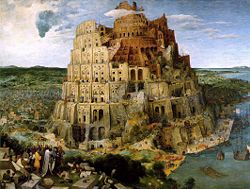
by Pieter Brueghel the Elder,
in Vienna's Kunsthistorisches Museum.
Contributions to painting and architecture have been especially rich. The Mosan art, the Early Netherlandish, and major examples of Romanesque, Gothic, Renaissance and Baroque architecture are milestones in the history of art. Famous names in this classic tradition include the Flemish artists Jan van Eyck, Rogier van der Weyden and, Pieter Brueghel the Elder as well as Lambert Lombard and Theodore de Bry from Liège. The historical artistic production of the Flemish before the early seventeenth century Baroque style of Peter Paul Rubens and Anthony van Dyck is often not distinguished from that of the Dutch. In the southern Netherlands it gradually declined thereafter, although high quality tapestry continued to be created until well into the eighteenth century.
During the nineteenth and twentieth centuries many original romantic, expressionist and surrealist Belgian painters emerged, including Egide Wappers, James Ensor, Constant Permeke and René Magritte. The avant-garde CoBrA movement appeared in the 1950s, while the sculptor Panamarenko remains a remarkable figure in contemporary art.
The multidisciplinary artist Jan Fabre and the painter Luc Tuymans are other internationally renowned figures on the contemporary art scene. Belgian contributions to architecture also continued into the nineteenth and twentieth centuries, including the work of Victor Horta and Henry van de Velde, who were major initiators of the Art Nouveau style.
Cinema
Belgian cinema, often influenced by the Dutch or French, has brought a number of mainly Flemish novels to life on-screen.[6] The absence of a major Belgian cinema company, however, has forced several talented directors to emigrate, such as Carl Colpaert or participate in low-budget productions such as Marc Didden's Brussels by Night (1983).
Other Belgian directors include André Delvaux, Stijn Coninx, Luc and Jean-Pierre Dardenne; well-known actors include Jan Decleir and Marie Gillain; and successful films include Man Bites Dog and The Alzheimer Affair.
In the 1980s, Antwerp's Royal Academy of Fine Arts produced important fashion trendsetters, known as the Antwerp Six.
Clothing
Cuisine
Belgium is well known for its cuisine. Many highly ranked restaurants can be found in the high-impact gastronomic guides, such as the Michelin Guide. Brands of Belgian chocolate, like Neuhaus, Guylian and Godiva, are world renowned and widely sold. This reputation of very high quality extends to sweets like the 'Caramella Mokatine', created by Confiserie Roodthooft in Antwerp in 1934.
Belgium produces over 500 varieties of beer. The biggest brewery in the world by volume is Inbev based in Belgium. Belgians have a reputation for loving waffles and French fried potatoes, both originated in their country. The national dishes are steak-fries and lettuce, and mussels-fries. A challenge for a television program caused no less than 307 different Flemish local or regional dishes to be presented on a 118-metre long table in Tivoli Park in Mechelen on 1 September 2007.
xxxx
Good cooking and fine beers are seen by many as part of Belgian culture. One of the many beers with the high prestige is that of the Trappist monks. Technically, it is an ale and traditionally each abbey's beer is served in its own glass (the forms, heights and widths are different). There are only seven breweries (six of them are Belgian) that are allowed to brew Trappist beer.
Although Belgian gastronomy is connected to French cuisine, some recipes were reputedly invented there as e.g. french fried potatoes (regardless that name), Vlaamse stoofkarbonnaden aka carbonnades flamandes (a beef stew with beer, mustard and laurel), speculaas (a sort of cookie), Belgian waffles, waterzooi (a broth made with chicken or fish, cream and vegetables), endive with bechamel sauce, Brussels sprouts, Belgian pralines (Belgium has some of the most renown chocolate houses), and Paling In 't Groen (river eels in a sauce of green herbs).
Belgian cookies are noted for their aroma and unique texture.
xxxx
Dance
Folklore
Folklore plays a major role in Belgium's cultural life: the country has a comparatively high number of processions, cavalcades, 'ommegangs' and 'ducasses',[7] 'kermesse', and other local festivals, nearly always with an originally religious background. The Carnival of Binche with its famous Gilles, and the 'Processional Giants and Dragons' of Ath, Brussels, Dendermonde, Mechelen and Mons are recognized by UNESCO as Masterpieces of the Oral and Intangible Heritage of Humanity.
Other examples are the Carnival of Aalst; the still very religious processions of the Holy Blood in Bruges, Virga Jesse in Hasselt, and Hanswijk in Mechelen; the August 15 festival in Liège; and the Walloon festival in Namur. Originated in 1832 and revived in the 1960s, the Gentse Feesten have become a modern tradition. A major non-official holiday is the Saint Nicholas Day, a festivity for children and, in Liège, for students.
Literature
Belgian literature as such does not exist. Flemish share their authors with the Dutch (see Dutch literature, Flemish literature), and French-speakers with the French (see French literature), which tend to confuse people on Belgian authors', several great French authors went to Belgium for refuge (e.g. Apollinaire, Baudelaire, Rimbaud, Verlaine) and conversely, top French-speaking writers often settle in Paris (e.g. Simenon, Amélie Nothomb). It is also sometimes difficult to cast Belgian authors into the French or Flemish category because many Flemish authors have written in French (e.g. Suzanne Lilar) and spent a large part of their lifes outside of Flanders or of Belgium (e.g. Emile Verhaeren or Maurice Maeterlinck). The confusion is also enhanced by the fact that many French-speaking individuals are coming from originally Dutch-speaking families (particularly in Brussels, e.g. Jacques Brel).
Belgium has produced several well-known authors such as poets: Guido Gezelle (1830-1899), Emile Verhaeren (1855-1916), Max Elskamp (1862-1931), Maurice Maeterlinck (1862-1949), Paul van Ostaijen (1896-1926), Henri Michaux (French born and educated in Belgium, 1899-1984) and Jacques Brel (1929–1978) and writers: Hendrik Conscience (1812-1883), Charles de Coster (1827-1879), Willem Elsschot (1882-1960), Michel de Ghelderode (1898-1962), Georges Simenon 1903-1989, Louis Paul Boon (1912-1979), Hugo Claus (born in 1929), Pierre Mertens (born in 1939) Ernest Claes (1885 - 1968), [[and, Amélie Nothomb (born in 1967).
Music
The vocal music of the Franco-Flemish School developed in the southern part of the Low Countries and was an important contribution to Renaissance culture. Most significant musically was the pervasive influence of musicians from the Low Countries, whose domination of the musical scene during the last half of the 15th century is reflected in the period designations the Netherlands school and the Franco-Flemish school.
The nineteenth and twentieth-centuries witnessed the appearance of major violinists, such as Henri Vieuxtemps, Eugène Ysaÿe and Arthur Grumiaux, while Adolphe Sax invented the saxophone in 1846. Belgium has also produced music of contemporary note. The first Belgian singer to successfully pursue an international career is Bobbejaan Schoepen, pioneer of varieté and pop music.
xxx
Many important classical composers were born in Belgium. The most famous is undoubtedly César Franck but Henri Vieuxtemps, Eugène Ysaÿe, Guillaume Lekeu and Wim Mertens are also noteworthy.
Well-known singers include pioneer Bobbejaan Schoepen, Jacques Brel, Johnny Hallyday (before he became French), Arno, and Maurane.
Adolphe Sax, the inventor of the saxophone, was born in Belgium. The country has also a very active jazz scene that is achieving international recognition with bands like Aka Moon, Maak's Spirit and Octurn. Harmonicist Toots Thielemans and guitarist Philip Catherine are probably the best known Belgian jazz musicians.
Hooverphonic, formed in the mid-1990s, is a Belgian pop / trip hop band that achieved international recognition through their inclusion on the soundtrack Bernardo Bertolucci's 1996 film Io Ballo da Sola (English: Stealing Beauty). Other popular Belgian pop music comes from Axelle Red, Vaya Con Dios, and K's Choice.
Belgium has also influenced electronic music with a.o. Front 242, Praga Khan (also known as Lords of Acid) and 2 Many DJ's, and rock music with dEUS.
Belgian hip-hop started with the rise of Starflam, CNN (a Brussels-based crew) and 't Hof van Commerce in the mid 1990s.
xxx
Philosophy
Science and technology
Contributions to the development of science and technology have appeared throughout the country's history. The sixteenth century Early Modern flourishing of Western Europe included cartographer Gerardus Mercator, anatomist Andreas Vesalius, herbalist Rembert Dodoens, and mathematician Simon Stevin among the most influential scientists. In the first half of the seventeenth century, the Walloon method of making bar iron found its way to Sweden where it remained in use for more than two hundred and sixty years.
The quickly developed and dense Belgian railroad system caused major companies like Brugeoise et Nivelles (now the BN division of Bombardier) to develop specific technologies, and the economically important very deep coal mining in the course of the First Industrial Revolution has required highly reputed specialized studies for mine engineers.
The end of the nineteenth century and the twentieth saw important Belgian advances in applied and pure science. The chemist Ernest Solvay and the engineer Zenobe Gramme gave their names to the Solvay process and the Gramme dynamo, respectively, in the 1860s. Georges Lemaître is credited with proposing the Big Bang theory of the origin of the universe in 1927. Three Nobel Prizes in Physiology or Medicine were awarded to Belgians: Jules Bordet in 1919, Corneille Heymans in 1938, and Albert Claude and Christian De Duve in 1974. Ilya Prigogine was awarded the Nobel Prize in Chemistry in 1977.
Theatre
Sport
Architecture
Sports
Football and cycling are especially popular amongst Belgians. Eddy Merckx is considered one of the greatest cyclists ever, given five victories of the Tour de France and numerous other bicycle races records; his hour speed record set in 1972 stood for twelve years. Belgium has produced two female tennis champions who repeatedly ranked number one of the world, Kim Clijsters and Justine Henin.
The Spa-Francorchamps motor-racing circuit hosts the Formula One World Championship Belgian Grand Prix. The Belgian driver Jacky Ickx won eight Grands Prix and six 24 Hours of Le Mans, and twice finished as runner-up in the Formula One World Championship. Thierry Boutsen also won three races in 1989 and 1990. Belgium also has a strong reputation in motocross; world champions include Roger De Coster, Joël Robert, Georges Jobé, Eric Geboers, Joël Smets and Stefan Everts.
Belgium has played a major part in the promotion and development of Duathlon. More specifically Benny Vansteelant has made a lasting legacy concquering a stunning 8 World Champion titles and 5 European Champion titles.
ReferencesISBN links support NWE through referral fees
General online sources
- Belgium. Encyclopædia Britannica Online. Encyclopædia Britannica, Chicago, IL, USA. Retrieved 2007-06-07.
- Boordtabel (in Dutch). Centre for Information, Documentation and Research on Brussels (BRIO) (2007). Retrieved 2007-06-02. (mentioning other original sources)
- CIA World Factbook entry on Belgium Retrieved on 2007-06-07.
- The Constitution. Federal Parliament Belgium (1997-01-21). Retrieved 2007-06-07.
- Country Portal - Europe — Belgium. Belgian Federal Government Service (ministry) of Economy — Directorate-general Statistics Belgium. Retrieved 2007-06-07.
- Fischer, Kathrin (1999-07-21). Die Stellung und Rolle der deutschsprachigen Minderheit in Ostbelgien innerhalb des belgischen Nationalstaats (in German). Kleiner Geländekurs in die EUREGIO Maas-Rhein. Geographical Institute of the Georg-August University (Department Culture and Social Geography), Göttingen, Germany. Retrieved 2007-06-13.
- History of Belgium. World History at KMLA. Korean Minjok Leadership Academy (KMLA) (Last revised 2007-05-30). Retrieved 2007-06-02.
- Janssens, Rudi, Vrije Universiteit Brussel (2001-06-01). Brusselse Thema's 8 — Taalgebruik in Brussel — Taalverhoudingen, taalverschuivingen en taalindentiteit in een meertalige stad (in Dutch, summary The Use of Languages in Brussels pp. 227–250 in English) (pdf) pp. 312 pp. VUBPress, Brussels ISBN 90 5487 293 4 – republished on web site of Centre for Information, Documentation and Research on Brussels (BRIO). Retrieved 2007-06-02.
- Leclerc, Jacques, membre associé du TLFQ (© 2006). Belgique • België • Belgien (in French). L'aménagement linguistique dans le monde. Host: Trésor de la langue française au Québec (TLFQ), Université Laval, Quebec. Retrieved 2007-06-02.
- Mnookin, Robert, Professor at HLS; Verbeke, Alain (2006-12-20). Bye bye Belgium?. International Herald Tribune, republished by Harvard Law School. Retrieved 2007-06-01. – Reflections on nations and nation-state developments regarding Belgium
Bibliography
- Arblaster, Paul (2005-12-23). A History of the Low Countries, Hardcover 312pp, Palgrave Essential Histories, Palgrave Macmillan, New York. ISBN 1-4039-4827-5 [Also edition (2005-12-23), Paperback 312pp, Palgrave Macmillan, New York, ISBN 1-4039-4828-3].
- Blom, J. C. H., Dutch State Institute for War Documentation, ed.; Lamberts, Emiel, Professor in Modern History KULeuven, ed.; Kennedy, James C., translator (May 1999). History of the Low Countries, Hardcover 503pp, Berghahn Books, Oxford/New York. ISBN 1-5718-1084-6 [Also newer edition (2006-06-29), Paperback 516pp, Berghahn Books, New York, ISBN 1-8454-5272-0].
- Cammaerts, Émile L. [1913] (1921). A History of Belgium from the Roman Invasion to the Present Day, 357pp, D. Appleton and Co, New York. OCLC 1525559 ASIN B00085PM0A [Also editions [1913], London, OCLC 29072911; (1921) D. Unwin and Co., New York OCLC 9625246; also published (1921) as Belgium from the Roman invasion to the present day, The Story of the nations, 67, T. Fisher Unwin, London, OCLC 2986704 ASIN B00086AX3A].
- Cook, Bernard A., Professor of History at Loyola University New Orleans, LA, USA (c2002 or May 2004). Belgium: A History, Paperback 205pp, Studies in Modern European History, Vol. 50, Peter Lang Pub, New York. ISBN 0-8204-5824-4 Ib. e-book (2004) NetLibrary, Boulder, CO, USA, ISBN 0-8204-7283-2 [Also print edition (2004-06-30 or 2005), ISBN 0-8204-7647-1].
- de Kavanagh Boulger, Demetrius C. [1902] (2001-06-28 or 2006-03-30). The History of Belgium: Part 1. Cæsar to Waterloo, Paperback 493pp, Elibron Classics, Adamant Media (Delaware corporation), Boston, MA, USA.. ISBN 1-4021-6714-8 [Facsimile reprint of a 1902 edition by the author, London]. – Ib. [1909] (2001-06-28 or 2006-03-30). Ib. Part 2. 1815-1865. Waterloo to the Death of Leopold I, Paperback 462pp, Ib., Ib. ISBN 1-4021-6713-X [Facsimile reprint of a 1909 edition by the author, London].
- Fitzmaurice, John (March 1996). The Politics of Belgium: A Unique Federalism, Paperback 284pp, Nations of the modern world, Westview Press, Boulder, CO, USA. OCLC 30112536. ISBN 0-8133-2386-X.
- Kossmann-Putto, Johanna A.; Kossmann Ernst H.; Deleu Jozef H. M., ed.; Fenoulhet Jane, translator [of: (1987). De Lage Landen : geschiedenis van de Noordelijke en Zuidelijke Nederlanden. Vlaams-Nederlandse Stichting Ons Erfdeel, Rekkem] [1987] (January 1993). The Low Countries: History of the Northern and Southern Netherlands, 3rd Rev. edition Paperback 64pp, Flemish-Netherlands Foundation "Stichting Ons Erfdeel", Rekkem, Belgium. ISBN 9-0708-3120-1 [several editions in English, incl. (1997) 7th ed.].
External links
- Belgium World Fact Book 2007, accessed November 25, 2007.
- Culture of Belgium Countries and Their Cultures, accessed November 25, 2007.
- Belgium, entry on the Catholic Encyclopedia 1913, republished on Wikisource
- Official site of Belgian monarchy
- Official site of the Belgian federal government
- Official Site of the Belgian Tourist Office in the Americas and GlobeScope,
- its links to sites of Belgian Tourist Offices in Belgium
- its links to sites of Belgian Tourist Offices worldwide - History of Belgium: Primary Documents EuroDocs: Online Sources for European History
- Belgium, entry on the Public Diplomacy wiki monitored by the USC Center on Public Diplomacy
- Expatica portal with background information and news on Belgium
Albania · Andorra · Armenia2 · Austria · Azerbaijan1 · Belarus · Belgium · Bosnia and Herzegovina · Bulgaria · Croatia · Cyprus2 · Czech Republic · Denmark3 · Estonia · Finland · France3 · Georgia1 · Germany · Greece · Hungary · Iceland · Ireland · Italy · Kazakhstan1 · Latvia · Liechtenstein · Lithuania · Luxembourg · Republic of Macedonia · Malta · Moldova · Monaco · Montenegro · Netherlands3 · Norway3 · Poland · Portugal · Romania · Russia1 · San Marino · Serbia · Slovakia · Slovenia · Spain3 · Sweden · Switzerland · Turkey1 · Ukraine · United Kingdom3 · Vatican City
1 Has majority of its territory in Asia. 2 Entirely in Asia but having socio-political connections with Europe. 3 Has dependencies or similar territories outside Europe.
Credits
New World Encyclopedia writers and editors rewrote and completed the Wikipedia article in accordance with New World Encyclopedia standards. This article abides by terms of the Creative Commons CC-by-sa 3.0 License (CC-by-sa), which may be used and disseminated with proper attribution. Credit is due under the terms of this license that can reference both the New World Encyclopedia contributors and the selfless volunteer contributors of the Wikimedia Foundation. To cite this article click here for a list of acceptable citing formats.The history of earlier contributions by wikipedians is accessible to researchers here:
- Belgium history
- History_of_Belgium history
- Politics_of_Belgium history
- Flemish_people history
- Wallonia history
- Education_in_Belgium history
- Culture_of_Belgium history
The history of this article since it was imported to New World Encyclopedia:
Note: Some restrictions may apply to use of individual images which are separately licensed.
- ↑ Structuur van de bevolking — België / Brussels Hoofdstedelijk Gewest / Vlaams Gewest / Waals Gewest / De 25 bevolkingsrijkste gemeenten (2000–2006) (in Dutch) (asp). Belgian Federal Government Service (ministry) of Economy — Directorate-general Statistics Belgium (© 1998/2007). Retrieved 2007-05-23.
- ↑ Footnote: Further reading: France in the 17th and 18th centuries
- ↑ Kris Deschouwer (January 2004). Ethnic structure, inequality and governance of the public sector in Belgium (pdf). United Nations Research Institute for Social Development (UNRISD). Retrieved 2007-05-22.
- ↑ Meredith, Mark (2005-06-06). The State of Africa, Hardcover 608pp, Free Press, pp. 95–96(?). ISBN 0-7432-3221-6.
- ↑ Cite error: Invalid
<ref>tag; no text was provided for refs namedfedgov1 - ↑ Notable Belgian films based on works by Flemish authors include: De Witte (author Ernest Claes) movie by Jan Vanderheyden & Edith Kiel in 1934, remake as De Witte van Sichem directed by Robbe De Hert in 1980; De man die zijn haar kort liet knippen (Johan Daisne) André Delvaux 1965; Mira ('De teleurgang van de Waterhoek' by Stijn Streuvels) Fons Rademakers 1971; Malpertuis (aka The Legend of Doom House) (Jean Ray [pen name of Flemish author who mainly wrote in French, or as John Flanders in Dutch]) Harry Kümel 1971 De loteling (Hendrik Conscience) Roland Verhavert 1974; Dood van een non (Maria Rosseels) Paul Collet & Pierre Drouot 1975; Pallieter (Felix Timmermans) Roland Verhavert 1976; De komst van Joachim Stiller (Hubert Lampo) Harry Kümel 1976; De Leeuw van Vlaanderen (Hendrik Conscience) Hugo Claus (a famous author himself) 1985; Daens ('Pieter Daens' by Louis Paul Boon) Stijn Coninx 1992; see also Filmarchief les DVD!s de la cinémathèque (in Dutch). Retrieved on 2007-06-07.
- ↑ Footnote: The Dutch word 'ommegang' is here used in the sense of an entirely or mainly non-religious procession, or the non-religious part thereof – see also its article on the Dutch-language Wikipedia; the Processional Giants of Brussels, Dendermonde and Mechelen mentioned in this paragraph are part of each city's 'ommegang'. The French word 'ducasse' refers also to a procession – see also its article on the French-language Wikipedia; the mentioned Processional Giants of Ath and Mons are part of each city's 'ducasse'.
